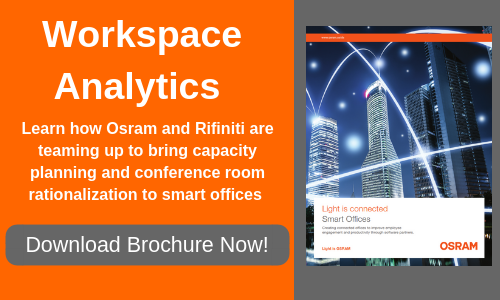Conference Room Optimization: Is your Company Wasting Space?
 Determining the right mix of coveted conference room space is a growing challenge for many organizations. Some struggle with a recurring shortage of available space rooms. Others are wasting money due to a chronic problem of vacant seats in meeting rooms. And many organizations wrestle with both – lack of available rooms and underutilized seats.
Determining the right mix of coveted conference room space is a growing challenge for many organizations. Some struggle with a recurring shortage of available space rooms. Others are wasting money due to a chronic problem of vacant seats in meeting rooms. And many organizations wrestle with both – lack of available rooms and underutilized seats.
So what factors are triggering these discrepancies?
Today’s workforce is increasing in mobility which is invalidating the familiar rules of thumb for planning the size, number and location of conference rooms. Flexible hours, remote work and mobile technology options have all changed how we use and book conference rooms. The popularity of webinars and online meeting tools means that fewer people physically attend meetings, leaving behind a considerable volume of underutilized space.
Many organizations have not been able to correct the resulting imbalances and adapt to changing demand. Too many firms still assume that measuring efficiency is done by assessing seat count per spare footage. This is misleading and in fact, many organizations continue to utilize an average of around 40% of available capacity.
The only way of determining optimal conference room number and size is to quantify actual space utilization. But before measurement comes into play, organizations need to start thinking of their real estate not merely as an expense but a strategic asset that drives business outcomes.
Smarter Strategic Decisions
To address this imbalance and rectify it in a meaningful way, organizations must rethink how they go about making space management decisions. This involves implementing measures that will help them keep up with the trends that affect fluctuating supply and demand. To strategically manage space, organizations need to:
- Reconfigure space. Rearranging space based on actual usage will boost space utilization, maximize productivity and improve collaboration.
- Rightsize the number of conference rooms. Doing so will lead to a better balance between supply and demand for meetings and collaborative space.
- Create flexible space. As technology continues to advance mobility and flexibility, workspace should reflect these innovative changes. One of the ways that’s done is by designing fluid space that can be modified accordingly, and on the go.
Measuring Space Utilization
To be able to reconfigure space and create a new design, companies need to gain a better understanding of how they currently utilize their conference room space. In other words, they need to uncover behavioral differences that determine how existing conference rooms are being used by different groups and at different times of the day. This is accomplished by measuring actual space utilization.
Measuring the way space is utilized entails procuring data on what is happening in the conference room over time. A smart lighting technology infrastructure is an ideal source for this data because occupancy sensors that are part of a smart lighting system are able to capture data at a granular level inside conference rooms.
Based on this data, companies can derive powerful, actionable insights to inform a whole new generation of space optimization initiatives that reduce real estate costs, boost financial performance and improve the employee experience. The end result is an implementation of modern workplace design that meets – and exceeds – the expectations of today’s employees.
High-level Analytics at Work
Sophisticated data science and machine-learning algorithms are light years ahead of the manual, error-prone data collection and crunching that many companies still rely on. This is why today’s forward-thinking companies mine data from an existing smart lighting system infrastructure to capture real-time insights. It’s also why they rely on advanced software to process this data and yield the granular insights required to unlock tremendous strategic and operational potential.
The algorithms quantify the use of space and provide analytics on a host of key performance indicators (KPIs) such as peak and average utilization, space efficiency, employee mobility and utilization and mobility by department. The foundation of deeper analytics is harmonizing several data sources as opposed to using a single source; which explains why the end result is a statistically accurate utilization of conference rooms rather than a laundry list of simple “attendance” numbers. Equally important is that all steps are taken to protect employee privacy. All data is encrypted and stripped of any personally identifiable information (PII) while all key identifiers are hashed.
Osram and Rifiniti have teamed up to offer smart building IoT solutions to the commercial real estate industry including optimized conference room space. The solutions combine rich data based on the smart lighting technology infrastructure by Osram with powerful workplace analytics software by Rifiniti.
To learn more about IoT-enabled workspace analytics, download the brochure below.

.png)
